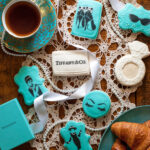
I am in love with reclaimed barn wood. I love to run my fingers over it– the ridges turned smooth from years of protecting its contents from lashing winds and driving snows. Sometimes the paint tells a story, too– you can see the layers of it weaving a tale as long and magical as the memories of those who originally dreamed it into reality.
I just love it.
And, as with most things I love, I wanted to turn this beautiful wood into a cookie. There are many “wood grain” tutorials out there. But I couldn’t find anything that really suited my needs, exactly. So I kind of built on the foundations of others and created my own look. Thanks to Bellissimo Cookies for her awesome driftwood tutorial, from which my original idea for this cookie sprung. 🙂
What are we waiting for? Let’s do this!
First, determine your shape. I’m using one of my favorite cutters– the rectangle plaque cutter. Choose a fairly stiff gray (outline texture– more on that here), and outline the cookie.
After the outlines have dried a bit (maybe 15 minutes), make a few squiggly lines in the center. You don’t have to cover the cookie– just include enough icing to smear over the surface.
Now, use a stiff brush to smear the icing inside the outline you have made. I took a cheapie paintbrush and cut the bristles unevenly. This worked perfectly.
Once you have the icing smeared around, go ahead and kind of smear it into long strokes. This makes the foundation for your boards. Let this gray foundation dry for about 5 minutes. You don’t want it completely dry– just the surface to be set.
Once your cookie has dried about 5 minutes, draw on some “boards.” I used a bench cutter for this, but you could use the dull end of a butter knife, as well, or even a toothpick. Just kind of make long lines, and then divide them up randomly into boards. Place a few dots by the small lines to make nail marks, if you like.
Let your boards dry for about 10 minutes. You want them to be firm enough that you can lightly paint the surfaces without crushing your hard work. Now, you need white. I used a white gel color (they make WHITE food coloring?). Yep. They do. Weird, but good in this case. You’d be surprised how often white gel comes in handy– but that’s another post for another time. Mix your white gel with some alcohol to water it down enough to make a lightweight paint. Some alcohols suitable for mixing with gel colors are almond or lemon extract, or vodka.
WAIT A MINUTE. I’m not putting ALCOHOL in my cookies! I don’t drink! Kids will be eating these! I don’t want guests getting drunk by the cookie table!
Stop worrying. I’ve never drunk anything stronger than Nyquil, and I use vodka for this. Here’s why. . . the alcohol never makes it to the cookie. It evaporates so quickly that no alcohol (or taste) is left. I promise you won’t even be able to tell. You also use so little (just a few drops) that I doubt you’d be able to taste anything even if it did stick around (which it doesn’t). Think of the alcohol as an ice bowl holding soup. By the time you’re done with the soup, the ice will be completely melted. It helps fulfill a purpose, but it’s gone by the end. But if you really have a problem using a few drops of vodka to dilute your gel, use almond extract. Just make sure your extract has a high alcohol content, and realize that your colors may not dry as quickly as if you had used vodka.
Take your thinned white gel and, with a fanbrush, apply a light coating of white to the gray.
The white on gray looked cool, but I wanted more color. Old barns kind of have a gray/white look from the years of weathering, but they usually have snippets of paint left, too. I chose to use brown, but you could use a dark red, too, as a nod to red barns, if you like. Dilute your brown gel the same way and put a super light coating of brown over the white. I loved how this turned out– it felt so real that I could hardly believe it was edible.
Photo by Jill Lang
You can use this wood for so many different things– a weathered wheelbarrow, a rustic sign that says “Apples” or “Pumpkins” for fall, or even a cutting board cookie if you’re going to make a cookie “cheese plate.” Oh my goodness . . . so much fun.
You did it. And I’m just so proud of you.

Disclosure: This post may contain affiliate links, which just means that we get a few pennies if you purchase through our link. I never recommend products that I don't personally use and love. Thanks!
















I happened onto your tutorials in Pinterest and these are fantastic your humor is sooo refreshing thank you tons!
Awww that makes my day. Thank you for taking the time to say that. <3 -- Emilie
Absolutely adorable ? Thank you for this tutorial ??
Thank you for the sweet comment! I’m glad you enjoyed the tutorial. 🙂 Love, Emilie
Pingback: Forest Moss Cookies – Cookies for England